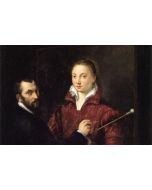Van Eyck and the Pre-Raphaelites
This course will be delivered online. See the ‘What is the course about?’ section in course details for more information.
- Course Code: VB961
- Dates: 08/07/24 - 08/07/24
- Time: 11:00 - 13:00
- Taught: Mon, Daytime
- Duration: 1 session
- Location: Online
- Tutor: Emma Rose Barber
Course Code: VB961
Duration: 1 session
Please note: We offer a wide variety of financial support to make courses affordable. Just visit our online Help Centre for more information on a range of topics including fees, online learning and FAQs.
What is the course about?
'The Arnolfini Portrait' (Jan van Eyck, active 1422-1441), dated to 1434 (the National Gallery) is one of the most iconic and legendary paintings in the history of Western art. 'The Awakening Conscience' (William Holman Hunt (1827-1910), dated to 1853 (Tate Britain) captures the moralising mood and status of women in Victorian Britain. Yet, despite being well-known paintings, they are rarely discussed together.
While both works depict a man and a woman in a lovingly painted interior, there might be other connections between them. The Pre-Raphaelites took inspiration from 15th-century Italian painting, but their art actually shows more allegiance to Netherlandish art. Through an in-depth study of these two paintings the lecture will address Hunt’s possible ‘borrowing’ of ideas from van Eyck; as well as the painting of ‘domestic’ rooms in the history of art; where narrative, attention to painting details and an air of ambiguity draw us in.
This short online course will explore the work of Van Eyck in relation to Holman Hunt and the art of the Pre-Raphaelites more generally and to consider the older artist's influence and association Pre-Raphaelite paintings of figures in interiors.
This is a live online course. You will need:
- Internet connection. The classes work best with Chrome.
- A computer with microphone and camera is best (e.g. a PC/laptop/iMac/MacBook), or a tablet/iPad/smart phone/iPhone if you don't have a computer.
- Earphones/headphones/speakers.
We will contact you with joining instructions before your course starts.
What will we cover?
• An exploration of two paintings in-depth from two different periods, but with elements in common.
• A consideration of artistic influence more widely and how artists absorb ideas and artistic processes.
What will I achieve?
By the end of this course you should be able to...
• Be able to describe two paintings in depth
• Be able to identify common points of interest and points of difference
• Be able to discuss two artists of two different artistic periods.
What level is the course and do I need any particular skills?
This course is suitable for all levels.
You should be able to follow simple written and verbal instructions, demonstrations, hand-outs and health and safety information, and will be invited to take part in group discussion.
How will I be taught, and will there be any work outside the class?
You will be taught online with lecture and slide presentations. You will be invited to participate in group discussion and ask questions during the session.
Are there any other costs? Is there anything I need to bring?
You might wish to purchase a notebook for taking notes. You might wish to buy some of the books on any reading list provided.
When I've finished, what course can I do next?
Search our lunchtime lectures or Friday Lates series for more introductions to the diversity of art history.
Emma Rose Barber is an art historian who has been teaching adults for over 25 years. She specialises in the visual culture of the Middle Ages and the Italian and Northern Renaissance. She has also taught classes on British art and has designed many different courses such as Last Suppers in Florence and Bosch, Breughel and the Surrealists. She has also given lectures on Women and Art. She used to run the history of art department at the British Institute in Florence and works for many institutions such as the Open University, Morley College and the department of continuing education at the University of Oxford. Her book – 111 Churches that you Shouldn’t Miss in London - is coming out in the autumn of 2020. She has spent the last five years with a Mini A-Z looking for churches to write about, many of which can be found on her blog – https://theitinerantchurchgoer.wordpress.com/. She is also writing a Cultural History of Wayfaring and writes articles for Selvedge Magazine.
Please note: We reserve the right to change our tutors from those advertised. This happens rarely, but if it does, we are unable to refund fees due to this. Our tutors may have different teaching styles; however we guarantee a consistent quality of teaching in all our courses.
